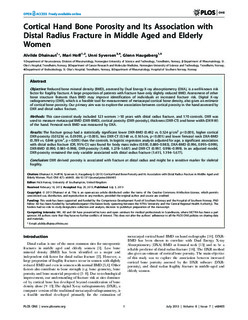Cortical hand bone porosity and its association with distal radius Fracture in middle aged and elderly women
Journal article, Peer reviewed
Permanent lenke
http://hdl.handle.net/11250/2367329Utgivelsesdato
2013Metadata
Vis full innførselSamlinger
Sammendrag
Objective:
Reduced bone mineral density (BMD), assessed by Dual Energy X-ray absorptiometry (DXA), is a well-known risk factor for fragility fracture. A large proportion of patients with fracture have only slightly reduced BMD. Assessment of other bone structure features than BMD may improve identification of individuals at increased fracture risk. Digital X-ray radiogrammetry (DXR), which is a feasible tool for measurement of metacarpal cortical bone density, also gives an estimate of cortical bone porosity. Our primary aim was to explore the association between cortical porosity in the hand assessed by DXR and distal radius fracture.
Methods:
This case-control study included 123 women >50 years with distal radius fracture, and 170 controls. DXR was used to measure metacarpal BMD (DXR-BMD), cortical porosity (DXR-porosity), thickness (DXR-CT) and bone width (DXR-W) of the hand. Femoral neck BMD was measured by DXA.
Results:
The fracture group had a statistically significant lower DXR-BMD (0.492 vs. 0.524 g/cm2 p<0.001), higher cortical DXR-porosity (0.01256 vs. 0.01093, p<0.001), less DXR-CT (0.148 vs. 0.161cm, p<0.001) and lower femoral neck DXA-BMD (0.789 vs. 0.844 g/cm2, p = 0.001) than the controls. In logistic regression analysis adjusted for age, a significant association with distal radius fracture (OR, 95% CI) was found for body mass index (0.930, 0.880–0.983), DXA-BMD (0.996, 0.995–0.999), DXR-BMD (0.990, 0.985–0.998), DXR-porosity (1.468, 1.278–1.687) and DXR-CT (0.997, 0.996–0.999). In an adjusted model, DXR-porosity remained the only variable associated with distal radius fracture (1.415, 1.194–1.677).
Conclusion:
DXR derived porosity is associated with fracture at distal radius and might be a sensitive marker for skeletal fragility.
